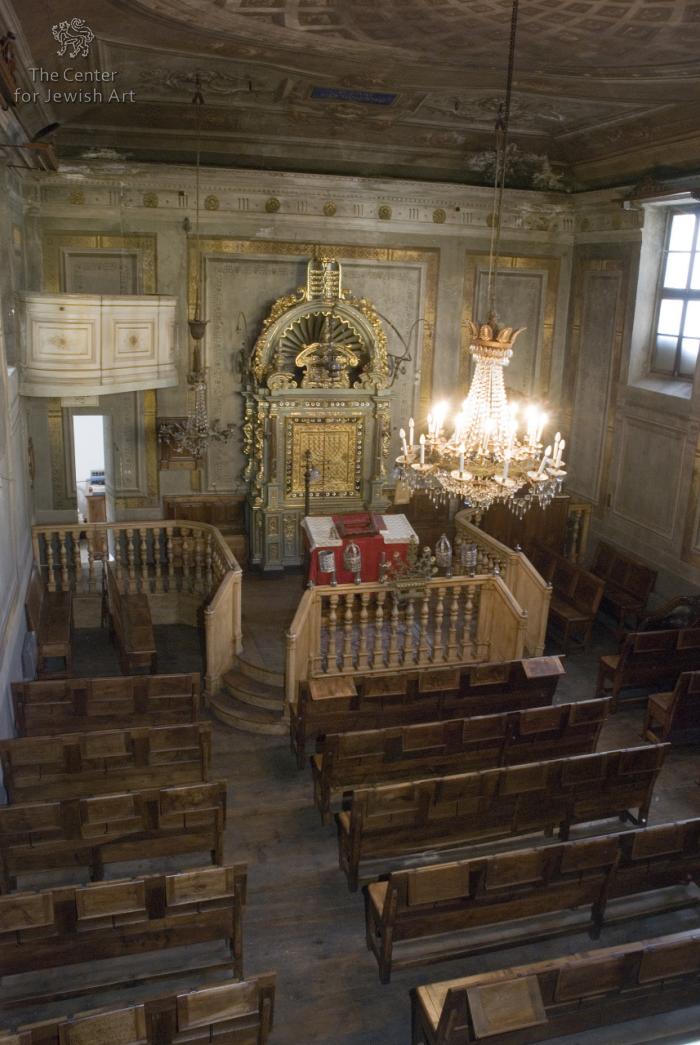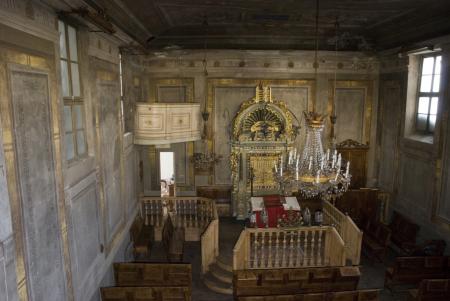Obj. ID: 11923
Jewish Architecture Synagogue in Cuneo, Prayer hall
To the main object: Synagogue in Cuneo, Italy

The prayer hall is a rectangular longitudinal space. The Torah Ark is placed in the center of the east wall, within a shallow niche. A platform delimited by a wooden fence is built in front of the Ark, where the Bimah is placed. A large and opulent chair, possibly for the elders of the synagogue, is to the right side of the Ark. A rounded podium is attached to the wall on the northeast corner, and was reached through a wooden staircase built in the office (see: Remarks: no. 1). Three rows of wooden benches are facing the Ark and Bimah.
An entrance door is on the southwest corner, while an additional door, leading to the communal office, is on the northeast corner. The women gallery runs along the western wall, and is reached through a staircase placed outside the prayer hall located in front of the Torah Ark, enclosed within a fenced platform. A pulpit was added to the north wall, however, during the years, it was not used and its staircase was removed.
The late 17th-century Tora hArk was not replaced in 1884, and its façade follows the tradition of the Piedmontese arks, before the Emancipation (compare to the arks of the synagogues in Chieri, Mondovi ,Asti, Casale Monferrato, Beit Zekenim in Torino, and the Torino Vercelezi's ark, now in the Eretz Israel Museumin Tel Aviv). The ark comprises two tiers; each is blocked by a double-winged door, adorned with Sanctuary Implements, such as the Ark of the Covenant, the seven-branched Menorah, the Shewbread Table and the Sacrifice and Incense Altars, on the surface. Mount Sina iwith the Tablets of the Covenants enclosing the Ten Commandments, appear on the inner face. Hebrew inscriptions accompany the Implements; some are Biblical citations while others are dedications.
The implements represent both the Tabernacle in the desert and the Temple in Jerusalem, expressing the wish to re-establish the Temple and carry out the liturgy there.
Few objects from the original early 17th century synagogue were found among the ritual objects, documented in the synagogue. A wooden small cabinet and an Alms box decorated with inlay Mother-of-Pearl and pieces of various woods are set within the synagogue's eastern and southern walls. The inscription on the cabinet indicates that it was dedicated to the synagogue in 1611.
These two wooden artifacts and a dedication attached to a pair of Torah finials reveal two different possible stages of the destroyed former synagogue; it can be assumed that the cabinet was dedicated to a synagogue that already existed in 1611. The dedication on the finials indicates the year 1697, as the fifth anniversary of the synagogue, thus it was built or renovated in 1692. No other information is known yet, about the destroyed 17th century synagogue. We hope that a further research would reveal more in the future.
Within the northeastern corner, an unexploded cannonball is embedded in the wall as a witness to a local miracle. It appears that in 1779, when the Austrian army conquered north Italy, the synagogue was also bombarded. However, the bomb fell with no casualties and the Jews announced this day as a day of celebration, named Purim katan (Small Purim) of Cuneo.
The wooden stairs were removed since the pulpit is no longer in use. The podium was built during the renovations of1884, inorder to adjust the synagogue to local churches, where the podium was used by the priests, during the Sunday Mass.

























